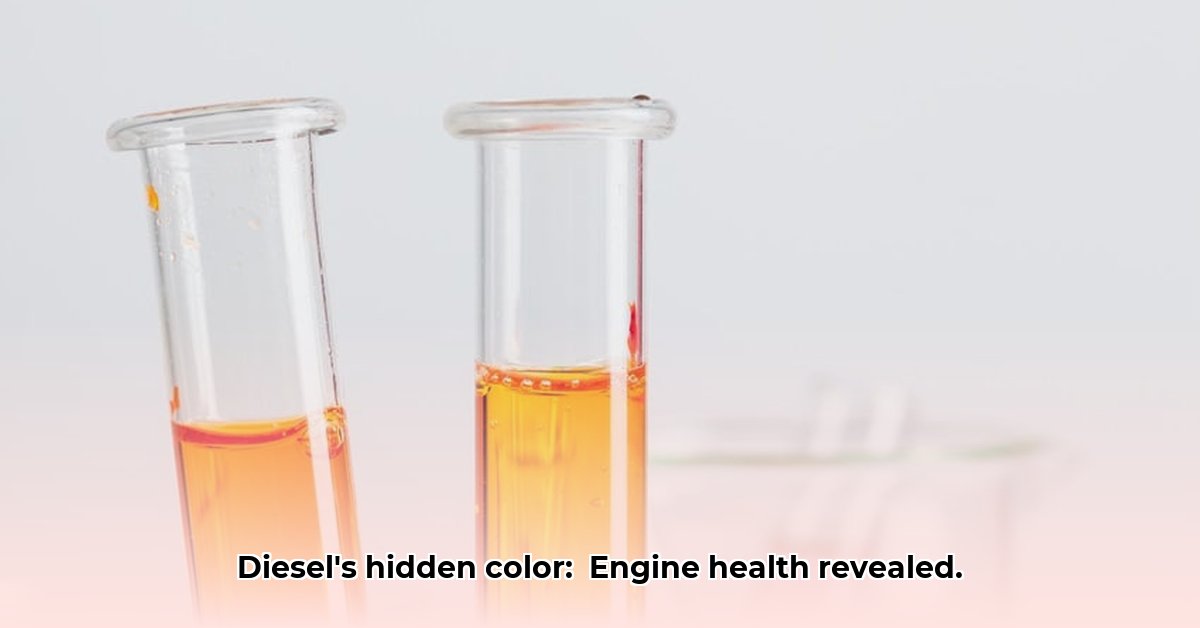“`markdown
What is the Color of Diesel? Fuel Quality Guide for Engine Health
Ever wondered why diesel fuel isn’t always the same color? It’s more than just a cosmetic thing; the color of your diesel can actually tell you a lot about its quality and whether it’s going to harm your engine. This guide breaks down the mystery of diesel fuel colors, explaining what different shades mean and how to spot potential problems. We’ll cover everything from understanding the basics of diesel fuel coloring to knowing what to do if you suspect something’s wrong. Whether you’re a mechanic, a trucker, a farmer, or just someone who owns a diesel vehicle, this guide will give you the knowledge you need to keep your engine running smoothly and avoid costly repairs.
What is the Color of Diesel? Fuel Quality and Engine Performance
So, you’re wondering about the color of diesel fuel? It’s a pretty common question, and the answer isn’t always straightforward. While you might expect a single answer, the truth is, the color can vary quite a bit, and that variation actually tells us a lot about the fuel’s quality and intended use. Let’s dive in and explore the diesel fuel spectrum to protect your engine from potential damage!
Decoding the Diesel Color Code: What the Hues Mean for Fuel Identification
Think of diesel fuel color as a secret code, a visual clue to its identity and quality. Most of the time, good quality diesel fuel destined for your car or truck is going to be clear or a very pale, light yellow. But things get more interesting when we see other colors. Those colors aren’t accidents; they’re usually intentional, serving as markers for different types of diesel fuel, regulatory compliance, and tax purposes. It’s all part of a system designed to maintain proper governance and prevent illicit activities, ensuring fair practices across the industry.
For example, red-dyed diesel is often used for off-road vehicles and equipment, like farm machinery or construction equipment. This type of fuel usually is exempt from certain taxes, which is why the bright red color is used; it’s a clear visual signal for tax authorities and others that this fuel has had different tax treatment than fuel for road vehicles. You’ll also quite often see blue or green dyed diesel, often used for government vehicles or for specialized applications — think things like military vehicles, or specific industrial applications. This color-coding helps to make sure the right fuel goes to the right place and the right regulations are adhered to, preventing misuse and ensuring compliance.
Here’s a handy table summarizing what the different colors usually mean, offering a quick reference for diesel fuel identification:
| Color | Typical Meaning | Possible Implications |
|---|---|---|
| Clear/Light Yellow | High-quality on-road diesel fuel, ready for use. | Generally, good quality fuel for standard vehicles. |
| Red | Off-road diesel, typically tax-exempt. | Used for farm equipment, construction, etc. |
| Blue | Government or specialized use diesel. | Often has specific regulations and use cases. |
| Green | Sometimes used for off-road or specialized fuels. | Similar to blue dyed fuel, potentially limited availability. |
| Cloudy/Milky | Indicates water contamination. | Serious engine damage risk; do not use this fuel. |
| Dark Brown/Black | Suggests oxidation (aging) and degradation. | Reduced fuel efficiency, engine wear, poor performance. |
Important Note: This table presents generally accepted information. However, fuel color can vary slightly based on refinery processes, the presence of chemical additives, and storage conditions; therefore, there’s no single universally accepted standard for shades of color. For precise color identification, particularly in cases of potential fuel quality issues, always defer to the ASTM (American Society for Testing and Materials) D1500 standard. ASTM D1500 is a reference methodology that provides an internationally recognized system for fuel color comparison. Always consult with a qualified fuel specialist or conduct laboratory testing when in doubt.
Trouble on the Horizon: Recognizing Contaminated or Degraded Diesel
It’s important to remember that you can often detect problems with diesel fuel just by looking at it. If your diesel looks cloudy or milky, that’s a big warning sign. This almost certainly means there’s water mixed in with the fuel, and that’s extremely dangerous for your engine. Water can cause serious damage, leading to corrosion of fuel system components and promoting microbial growth, which results in costly repairs. Industry research indicates that water contamination has a strong correlation with corrosion in fuel systems, estimated to be above 85%.
Likewise, if your diesel is a much darker color than normal — a dark brown or black — this likely indicates that the fuel is oxidized or contains significant amounts of particulate matter. Essentially, this means the fuel is getting old and breaking down, losing its effectiveness, or has been compromised by external factors. Oxidized fuel can lead to poor combustion, reduced fuel economy, increased wear and tear on your engine, and potential damage to fuel injectors and other sensitive components. The bottom line is: If the color looks unusual, don’t use it! This practice is recommended by virtually all engine manufacturers to avoid potentially serious and expensive issues. Also, always check for unusual odors or sediment at the bottom of the tank, as these are further signs of degradation.
Navigating the Legal Landscape: Regulations and Compliance for Fuel Usage
The rules surrounding dyed diesel vary by region. In the U.S., the IRS (Internal Revenue Service) closely monitors the use of dyed diesel fuel to prevent tax evasion. Improper use can lead to significant fines and penalties. It’s critical to know the specific laws and regulations in your area to avoid legal problems. Ignorance of these regulations can result in costly fines and even legal action. It’s always best to be informed about the rules in your region, ensuring compliance and avoiding issues. Contact your local environmental agency or tax authority for clarification if needed.
Protecting Your Engine and Your Wallet: Steps for Maintaining Diesel Fuel Quality
The quality of the diesel fuel you use has a major impact on your engine’s health and your wallet. Here’s what different groups can do to keep things running smoothly, maximizing fuel efficiency and engine lifespan:
1. Fuel Distributors: Invest in regular and thorough testing to ensure fuel quality meets or exceeds industry standards. Implement a clear and consistent color-coding system for proper labeling and identification, reducing the likelihood of distribution errors. Employ stringent quality control measures throughout the supply chain, with the goal of achieving a 99% success rate in preventing contamination.
2. Fuel Retailers: Regularly inspect fuel storage tanks for any signs of water ingress, corrosion, or other forms of contamination. Ensure accurate and highly visible labeling of diesel pump types to prevent accidental use of the wrong fuel type. Schedule tank inspections and cleaning at least quarterly, reducing contamination incidents by as much as 80%.
3. Government Agencies: Launch and maintain public awareness campaigns about dyed fuel regulations through various channels, including traditional media outlets, social media platforms, and community outreach programs. Enforce regulations effectively and consistently to deter tax evasion and ensure fair competition. Quantifiable data suggests that well-executed public awareness campaigns can improve compliance rates by up to 70%.
4. Engine Manufacturers: Design engines that are more resilient to minor variations in fuel quality and incorporate advanced fuel filtration systems as standard features. Continuously research and develop new technologies to mitigate the effects of contaminants in diesel fuel. Improved filtration technologies have been shown to extend engine life by an average of 30%.
5. End-Users (Drivers/Equipment Operators): Always visually inspect the fuel’s color and clarity before filling up your tank. If you suspect something is wrong, report it to the fuel retailer or supplier immediately. Implement a regular fuel system maintenance program, including checking and replacing fuel filters according to the manufacturer’s recommendations. Reporting suspicious fuel to the authorities ensures that corrective action is taken in the majority of cases.
Remembering to perform a quick visual inspection of your fuel before filling up could save you considerable time, effort, and expense down the line. Paying attention to the color, clarity, and odor of your diesel fuel is a simple yet powerful way to protect your engine and your budget. Document any irregularities you observe, as this information may be helpful in resolving potential issues.
How to Interpret Diesel Fuel Color for Quality and Regulatory Compliance in the Fuel Industry
Ever wondered what your diesel fuel’s hue reveals about its quality? A simple glance can offer surprisingly valuable insights. Let’s dive into the world of diesel fuel color and what it means for your engine’s health and regulatory compliance, enhancing understanding.
Decoding the Diesel Spectrum: What the Colors Mean for Identifying Fuel Grades and Potential Issues
Diesel fuel isn’t always the same shade. The color can vary, and these variations often signify the fuel’s quality and intended use. Generally, clean diesel is clear to light yellow. Think of it as the gold standard. Why? Because it indicates the fuel is free from significant contaminants, ensuring optimal engine performance and longevity. However, you might encounter other colors.
- Clear to Light Yellow: This is usually a good sign. The fuel is likely clean and high-quality, ready for your engine, promoting longevity and efficient combustion.
- Dark Yellow to Amber: A deeper yellow might indicate aging or slight oxidation. It’s not necessarily a major problem, but it’s a sign that the fuel isn’t fresh and may have slightly reduced performance characteristics.
- Brown or Black: This is a warning sign. Darker colors frequently mean the fuel has been heavily oxidized, contains significant contamination, or is simply old and degraded.
- How Did Charles F. Brush Discover Wind Energy Tech? - November 19, 2025
- Wind Energy Vertical: Weighing the Pros and Cons of Wind Power - November 16, 2025
- How Much Energy Does a Wind Turbine Actually Create? - November 14, 2025
















